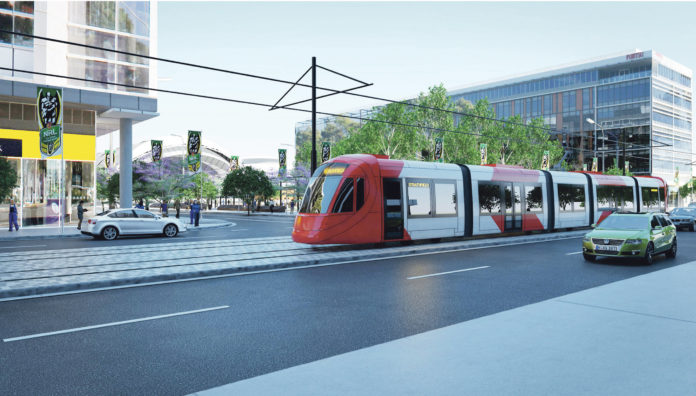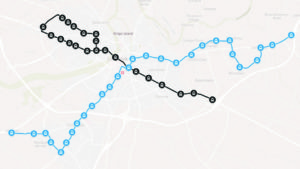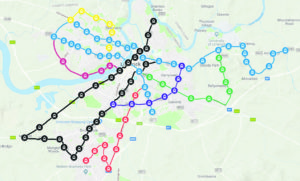
A Limerick light rail network would help drive the city’s future development. Rian Mac Giobúin, founder of the Eireannachtharlear.com website, gives some substance to the proposal.
IN AUGUST 2017, Limerick City and County Council announced it was developing a new transport strategy with work expected to get underway in early 2018.
Yet, despite a further statement in early 2018 confirming that there was no delay in developing the strategy, it still hasn’t been published.
In the meantime, public transport in Limerick has gone from bad to worse and Cork has announced an integrated transport strategy which includes the development of a €1 billion light rail network.
The route will be approximately 17km in length, include 25 stops and run from Ballincollig to Mahon Point, serving around 32 per cent of Cork’s metropolitan population and around 60 per cent of all future employment.
According to the Cork strategy, light rail transport (LRT) carries almost twice as many passengers than either bus-based public transport or bus rapid transit.
LRT has been a massive success in Dublin and many cities across Europe. Passenger numbers on the LUAS increased by 10.26 per cent to 37.6 million in 2017. In the last eight years alone passenger traffic on the LUAS has grown by 50 per cent and since the two lines were connected in 2016 revenues are up more than 30 per cent on the Green line and seven per cent on the Red line.

Passengers simply love trams and it’s easy to see why. They can carry large numbers of people and, unlike a bus, capacity can be easily increased during peak times by adding extra cars without the need to hire more drivers. They offer better access for people with reduced mobility, parents with prams and people with heavy luggage as station platforms are designed so that they are at exactly the same level as the tram floors.
They are less likely to break down and can be given priority ahead of other road users through the use of detection systems that ensure they have priority at traffic lights, roundabouts and level crossings. Trams can also run on 100 per cent dedicated tracks which means they won’t become stuck in motor traffic.
According to a submission made to the government in 2017 by the local authorities in Limerick, Clare and Tipperary, the Limerick Metropolitan area should be developed to cater for a population of 300,000 people by the year 2040.

If this is to become a reality, Limerick needs to urgently develop a transport strategy and seriously consider the development of a light rail network that will allow the city to reach its true potential.
While the long-term goal must be to develop a network covering the entire city, the first phase would see the connection of the most densely populated residential areas, key business parks, hospitals and educational facilities.
One potential route could see the connection of the new housing developments proposed for Mungret, with Raheen Industrial Park, University Hospital Limerick, Dooradoyle, the Crescent Shopping Centre, Limerick City Centre, Con Colbert Train Station, St John’s Hospital, the Parkway Shopping Centre, the University of Limerick, Castletroy, Monaleen and Annacotty.
The route would see the two most densely populated residential areas in Limerick (Dooradoyle and Castletroy) connected with the city centre by 16.6 km of rail, which would be slightly shorter than the route being proposed in Cork.
The cost of the line could be subsidised by EU funding and levies on development in areas close to the projected route. Cork City Council have recently sent a delegation to Europe to discuss funding for its proposals.
In time, the line could be extended to connect Mungret with the city centre via the Dock Road, potentially opening up land for residential development along the docklands and Greenpark Race Course.
Other routes could include a line along the old Foynes railway track connecting Raheen industrial park and the new housing developments proposed for the south of the city with the wider network.
A number of interconnected lines on the north of the city could provide access to Thomond Park, the Gaelic Grounds, Jetland Shopping Centre, LIT, Thomond and Cratloewood student villages, Caherdavin, the Ennis Road and park and ride facilities at Coonagh for commuters arriving from Shannon and Ennis.
The line would also open up land for development to the north of the Shannon river and connect Moyross and Ballynanty with the rest of the city.
The eastern part of the city could be serviced by a line running from a park and ride facility at the Newport Roundabout via Annacotty, Monaleen, Kilmurray, UL and Groody. This could be connected to a line running from Castletroy to City East via the Golf Links Road and into the city centre.
It’s hard not to feel that Limerick is on the road to success. €1.5 billion has been invested in the city and 15,000 jobs created over the last four years. If this is to continue it has to have a public transport system to match that ambition.
Limerick should be learning from the mistakes made in Dublin which is now the second most congested city in Europe and the third in the world. Transport initiatives such as the connection of the LUAS lines or the development of a metro are now becoming increasingly costly and disruptive for the city.
Limerick is fortunate in that it is small enough to design and construct a world-class transport network with relatively low levels of disruption. By developing the transport network now, the city can grow around it over the next 20 to 30 years, instead of retrofitting when it’s too late.










